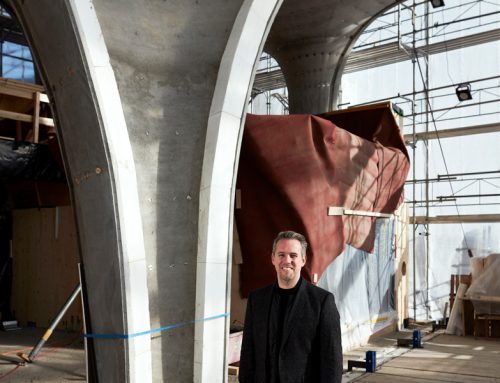 I knew there was something special about the chiffonier when I saw it standing on auction in the once grand dining room of No 2 Richmond Road, a Victorian home in the town of Middelburg in the Karoo.
I knew there was something special about the chiffonier when I saw it standing on auction in the once grand dining room of No 2 Richmond Road, a Victorian home in the town of Middelburg in the Karoo.
When auctioneer Richard Rogers, also a wellknown farmer in the area, reached the circa 1836 chiffonier, the room hushed to attention in anticipation of the bidding for this showpiece of the day.
First he explained that a chiffonier is a grand sideboard, so-named because in its original form a curtain of chiffon covered the doors at its base, which in this case had been replaced with mirrors.
Then he evocatively described the history of the chiffonier while auction attendants slowly pushed forward to get a closer look, their images reflecting in its time-aged mirrors.
The chiffonier originally found its way to Middelburg with Sir Frederic de Waal – the driving force behind Chapman’s Peak Drive in Cape Town and after whom De Waal’s Drive is named.
His move to Middelburg in the 1880s was motivated by chest problems, as the Karoo was widely renowned for its healing powers. He established himself as a newspaper editor and businessman and lived at No 2 Richmond Road, comforted by his chiffonier and many other beautiful objects transported from England.
The chiffonier has in its time been the showpiece at a few auctions. The late 1920s saw it moving to the farm Mazeppa, some 30km from Middelburg. The 1940s saw it moving back to No 2 Richmond Road and remaining here until this most recent sale.
Now the bids were on again, and back and forth they went until the current owners of Mazeppa, Piet and Estelle Herholdt, won the day for the extremely fortunate price of R8 000. They were prepared to go to R20 000, such was their interest in this piece.
And so it was that the next time I saw the chiffonier it was proudly ensconced in the sitting room of the immaculate 1929 homestead at Mazeppa, where it had stood many decades before.
It was here that I heard the remarkable tale of Mazeppa, told to me by Piet Herholdt, whose family has been in Middelburg since the early 1800s when his grandfather repaired and did signwriting on ox wagons.
“When we bought Mazeppa in 1970 we started trying to find out about its history and why it has this name, which is shared by Mazeppa Bay on the Transkei coast,” he explained as we drank tea on the wrap-around veranda of their home. “What we discovered is that this home was built in 1929 as a seven-bedroom guest house, by a sheep farmer named Stephen Botha who used bricks made on the farm.”
At that time, goods and passenger trains ran past this way several times a day, from Joburg to Mossel Bay, and there was a passenger station a stone’s throw from the house. It was an extremely popular route, renowned far and wide, and Mazeppa became well known.
“Couples from England would come out to South Africa and catch the train to Mazeppa to have their honeymoon,” continued Piet, who celebrates his 50th wedding anniversary with Estelle this year.
As you can tell from the house today, it must have been a grand guest house, sumptuously furnishedin the Victorian style, with the chiffonier occupying pride of place.
Stephen is no longer around to confirm why Mazeppa was so-named, but around the time that he completed the homestead, a movie called Mazeppa, based on a romantic poem penned by Lord Byron in 1818, was produced in the United States.
Either this captured Stephen’s imagination or he was a lyrical fellow and drawn in by Byron’s poem, which was widely celebrated and inspired an enduring, worldwide ‘Mazeppa cult’. Everything from ships to patterns of cutlery and crockery were named Mazeppa for many a decade. Mazeppa Bay was named after a ship called Mazeppa that used to land goods there in the 1930s.
Piet and Estelle have a Mazeppa knife that destiny dropped in their laps when they helped a couple from Willowmore who knocked on their door one night after their car had broken down. “They asked us about the name Mazeppa, as they had a knife stamped with ‘Mazeppa’ and an unusual logo of a man strapped to a horse. They kindly sent it to us as a thank you gift,” said Piet.
The unusual logo brings us to Byron’s poem, which was based on a popular legend about a 17th-century courtier named Ivan Mazeppa who, as a young man, served in the court of the Polish King. Mazeppa had a passionate and illicit love affair with a countess who was married to a count some 30 years her senior.
Unable to contain himself, Mazeppa would organise secret meetings with the countess in the dark of night to consummate their love. The count got wind of their affair and punished Mazeppa by tying him naked to a wild stallion and setting it loose.
The poem describes the stallion’s frenzied flight across sub-zero eastern Europe to the Ukraine and the pain and suffering that Mazeppa endures strapped to its back. He almost dies twice, staring the afterworld full in the face, but he survives and later becomes a Cossack leader, celebrated by the Ukrainians for his endurance and courage. He was much admired by Tsar Peter the Great and given authority over all the Ukraine, building schools and churches in a style still known as Mazeppa Baroque. Although none of this made up for his lost love, who he never saw again.
Stephen Botha’s Mazeppa is far more Victorian than Mazeppa Baroque, but it too has its own romantic-tragic tale, witnessed by the chiffonier. Stephen had a son, Douglas, who was all too partial to the bottle and not a good farmer like his father. Hoping to ‘find himself ’ in war, Douglas headed to Egypt to fight with the South African forces during World War II.
“In those days they asked people, especially women, to write to the soldiers and to knit them socks and jerseys,” Piet continued. Douglas received both from a woman, and they struck up regular and ‘friendly’ correspondence. On his return from the war he invited the woman, with whom he had fallen in love across the miles but whom he had never seen (not even in a photograph!), to catch the train to Mazeppa, with the promise of marriage. He eagerly awaited her arrival, but was apparently bitterly disappointed when a very large woman alighted from the train. As is often the case in this cruel world, her charming turn of phrase was not enough to win him over, but he nevertheless fulfilled his promise and married her.
Douglas then took even more actively to the bottle and the marriage was not a happy one, lasting but a few years. The story goes that they got divorced and the ex-wife moved into one of the outbuildings behind the homestead. Douglas remarried, an Englishwomanwho moved into the main house.
The chiffonier can attest it was not a happy time. After his father died, Douglas drank away his inheritance and sold off parts of the farm until the original 10 000 hectares were whittled down to the current 550.
After Douglas’s death in the late 1940s, the Englishwoman put all the furniture in the house on auction and the chiffonier was bought by the Vorster family who lived at No 2 Richmond Road and had arrived in the Karoo in 1725. This is where it remained until the latest auction.
Now that the chiffonier is back at Mazeppa, Piet and Estelle relax in the sitting room of their stately home and listen to Franz Liszt’s ‘Mazeppa’, composed in 1851. The chiffonier listens along while it gazes out over Estelle’s lovingly tended garden and the plains of the Karoo, mirroring the moods of yesterday, today and tomorrow in its time-aged glass.




